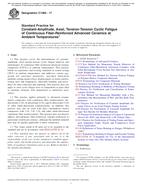We need your consent to use the individual data so that you can see information about your interests, among other things. Click "OK" to give your consent.
ASTM C1360-17
Standard Practice for Constant-Amplitude, Axial, Tension-Tension Cyclic Fatigue of Continuous Fiber-Reinforced Advanced Ceramics at Ambient Temperatures
Translate name
STANDARD published on 1.2.2017
The information about the standard:
Designation standards: ASTM C1360-17
Note: WITHDRAWN
Publication date standards: 1.2.2017
SKU: NS-676143
The number of pages: 9
Approximate weight : 27 g (0.06 lbs)
Country: American technical standard
Category: Technical standards ASTM
The category - similar standards:
Annotation of standard text ASTM C1360-17 :
Keywords:
ceramic matrix composite, CFCC, continuous fiber ceramic composite, cyclic fatigue, S-N curve, tension-tension cyclic fatigue,, ICS Number Code 81.060.30 (Advanced ceramics)
Additional information
| Significance and Use | ||||||||||||||||||||||||||||||
|
4.1 This practice may be used for material development, material comparison, quality assurance, characterization, reliability assessment, and design data generation. 4.2 Continuous fiber-reinforced ceramic matrix composites are generally characterized by crystalline matrices and ceramic fiber reinforcements. These materials are candidate materials for structural applications requiring high degrees of wear and corrosion resistance, and high-temperature inherent damage tolerance (that is, toughness). In addition, continuous fiber-reinforced glass matrix composites are candidate materials for similar but possibly less demanding applications. Although flexural test methods are commonly used to evaluate the mechanical behavior of monolithic advanced ceramics, the nonuniform stress distribution in a flexural test specimen in addition to dissimilar mechanical behavior in tension and compression for CFCCs leads to ambiguity of interpretation of test results obtained in flexure for CFCCs. Uniaxially loaded tensile tests provide information on mechanical behavior for a uniformly stressed material. 4.3 The cyclic fatigue behavior of CFCCs can have appreciable nonlinear effects (for example, sliding of fibers within the matrix) which may be related to the heat transfer of the specimen to the surroundings. Changes in test temperature, frequency, and heat removal can affect test results. It may be desirable to measure the effects of these variables to more closely simulate end-use conditions for some specific application. 4.4 Cyclic fatigue by its nature is a probabilistic phenomenon as discussed in STP 91A (1) and STP 588 (2).4 In addition, the strengths of the brittle matrices and fibers of CFCCs are probabilistic in nature. Therefore, a sufficient number of test specimens at each testing condition is required for statistical analysis and design, with guidelines for sufficient numbers provided in STP 91A 4.5 Tensile cyclic fatigue tests provide information on the material response under fluctuating uniaxial tensile stresses. Uniform stress states are required to effectively evaluate any nonlinear stress-strain behavior which may develop as the result of cumulative damage processes (for example, matrix microcracking, fiber/matrix debonding, delamination, cyclic fatigue crack growth, etc.) 4.6 Cumulative damage due to cyclic fatigue may be influenced by testing mode, testing rate (related to frequency), differences between maximum and minimum force (4.7 The results of cyclic fatigue tests of test specimens fabricated to standardized dimensions from a particular material or selected portions of a part, or both, may not totally represent the cyclic fatigue behavior of the entire, full-size end product or its in-service behavior in different environments. 4.8 However, for quality control purposes, results derived from standardized tensile test specimens may be considered indicative of the response of the material from which they were taken for given primary processing conditions and post-processing heat treatments. 4.9 The cyclic fatigue behavior of a CFCC is dependent on its inherent resistance to fracture, the presence of flaws, or damage accumulation processes, or both. There can be significant damage in the CFCC test specimen without any visual evidence such as the occurrence of a macroscopic crack. This can result in a loss of stiffness and retained strength. Depending on the purpose for which the test is being conducted, rather than final fracture, a specific loss in stiffness or retained strength may constitute failure. In cases where fracture occurs, analysis of fracture surfaces and fractography, though beyond the scope of this practice, is recommended. |
||||||||||||||||||||||||||||||
| 1. Scope | ||||||||||||||||||||||||||||||
|
1.1 This practice covers the determination of constant-amplitude, axial tension-tension cyclic fatigue behavior and performance of continuous fiber-reinforced advanced ceramic composites (CFCCs) at ambient temperatures. This practice builds on experience and existing standards in tensile testing CFCCs at ambient temperatures and addresses various suggested test specimen geometries, specimen fabrication methods, testing modes (force, displacement, or strain control), testing rates and frequencies, allowable bending, and procedures for data collection and reporting. This practice does not apply to axial cyclic fatigue tests of components or parts (that is, machine elements with nonuniform or multiaxial stress states). 1.2 This practice applies primarily to advanced ceramic matrix composites with continuous fiber reinforcement: uni-directional (1-D), bi-directional (2-D), and tri-directional (3-D) or other multi-directional reinforcements. In addition, this practice may also be used with glass (amorphous) matrix composites with 1-D, 2-D, 3-D, and other multi-directional continuous fiber reinforcements. This practice does not directly address discontinuous fiber-reinforced, whisker-reinforced or particulate-reinforced ceramics, although the methods detailed here may be equally applicable to these composites. 1.3 The values stated in SI units are to be regarded as the standard and are in accordance with IEEE/ASTM SI 10. 1.4 This standard does not purport to address all of the safety concerns, if any, associated with its use. It is the responsibility of the user of this standard to establish appropriate safety and health practices and determine the applicability of regulatory limitations prior to use. Refer to Section 7 for specific precautions. |
||||||||||||||||||||||||||||||
| 2. Referenced Documents | ||||||||||||||||||||||||||||||
|
We recommend:
Technical standards updating
Do you want to make sure you use only the valid technical standards?
We can offer you a solution which will provide you a monthly overview concerning the updating of standards which you use.
Would you like to know more? Look at this page.




 Cookies
Cookies
